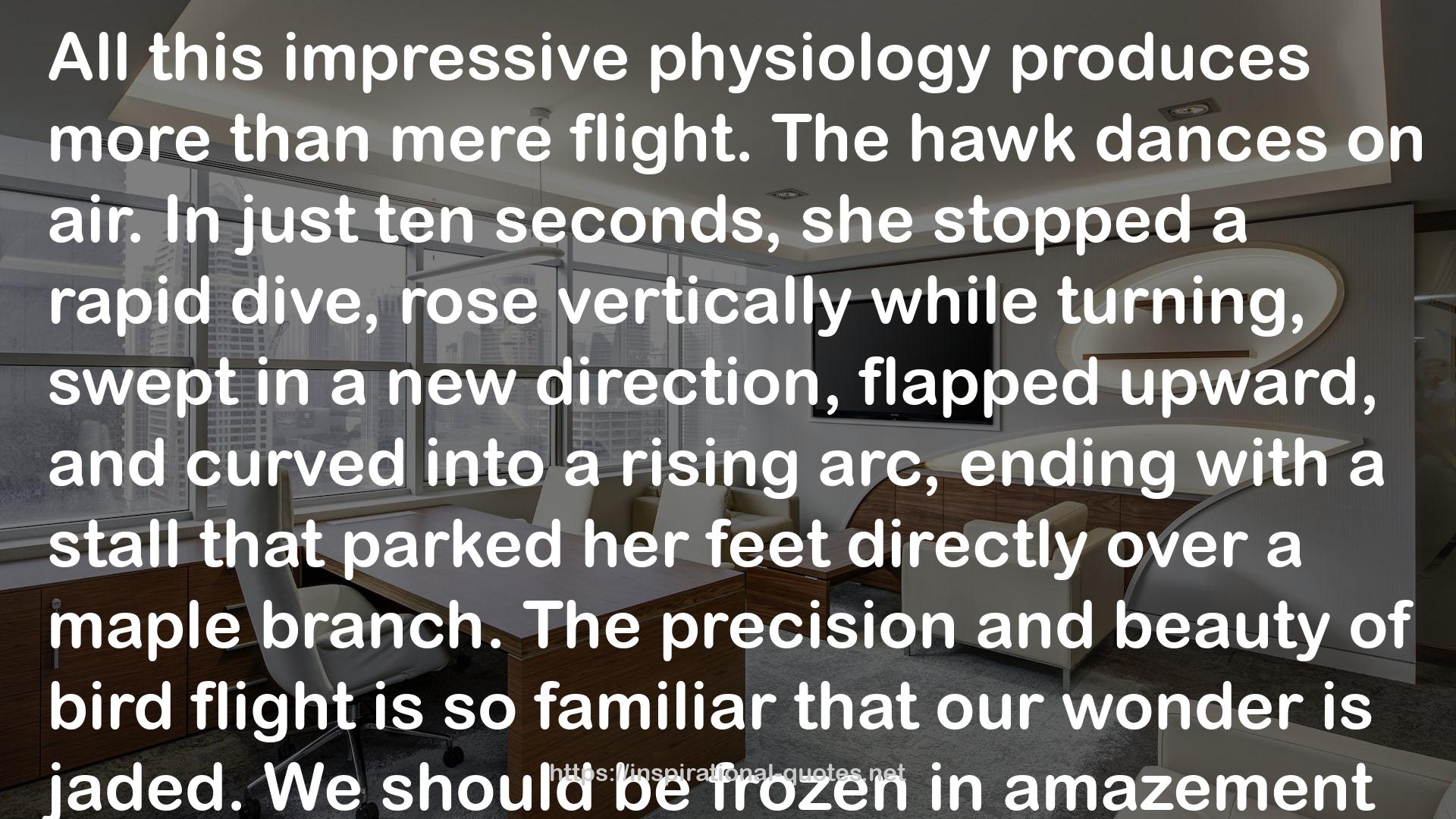1
" All this impressive physiology produces more than mere flight. The hawk dances on air. In just ten seconds, she stopped a rapid dive, rose vertically while turning, swept in a new direction, flapped upward, and curved into a rising arc, ending with a stall that parked her feet directly over a maple branch. The precision and beauty of bird flight is so familiar that our wonder is jaded. We should be frozen in amazement at the cardinal landing on the feeder or the sparrow banking around cars in a parking lot. Instead, we walk by as if an animal pirouetting on air were unremarkable, even mundane. The hawk's dramatic rise over the mandala's center jolts me out of dullness, pulling away the blinding layers of familiarity. "
― , The Forest Unseen: A Year’s Watch in Nature
2
" Wild animals enjoying one another and taking pleasure in their world is so immediate and so real, yet this reality is utterly absent from textbooks and academic papers about animals and ecology. There is a truth revealed here, absurd in its simplicity.
This insight is not that science is wrong or bad. On the contrary: science, done well, deepens our intimacy with the world. But there is a danger in an exclusively scientific way of thinking. The forest is turned into a diagram; animals become mere mechanisms; nature's workings become clever graphs. Today's conviviality of squirrels seems a refutation of such narrowness. Nature is not a machine. These animals feel. They are alive; they are our cousins, with the shared experience kinship implies.
And they appear to enjoy the sun, a phenomenon that occurs nowhere in the curriculum of modern biology.
Sadly, modern science is too often unable or unwilling to visualize or feel what others experience. Certainly science's "objective" gambit can be helpful in understanding parts of nature and in freeing us from some cultural preconceptions. Our modern scientific taste for dispassion when analyzing animal behaviour formed in reaction to the Victorian naturalists and their predecessors who saw all nature as an allegory confirming their cultural values. But a gambit is just an opening move, not a coherent vision of the whole game. Science's objectivity sheds some assumptions but takes on others that, dressed up in academic rigor, can produce hubris and callousness about the world. The danger comes when we confuse the limited scope of our scientific methods with the true scope of the world. It may be useful or expedient to describe nature as a flow diagram or an animal as a machine, but such utility should not be confused with a confirmation that our limited assumptions reflect the shape of the world.
Not coincidentally, the hubris of narrowly applied science serves the needs of the industrial economy. Machines are bought, sold, and discarded; joyful cousins are not. Two days ago, on Christmas Eve, the U.S. Forest Service opened to commercial logging three hundred thousand acres of old growth in the Tongass National Forest, more than a billion square-meter mandalas. Arrows moved on a flowchart, graphs of quantified timber shifted. Modern forest science integrated seamlessly with global commodity markets—language and values needed no translation.
Scientific models and metaphors of machines are helpful but limited. They cannot tell us all that we need to know. What lies beyond the theories we impose on nature? This year I have tried to put down scientific tools and to listen: to come to nature without a hypothesis, without a scheme for data extraction, without a lesson plan to convey answers to students, without machines or probes. I have glimpsed how rich science is but simultaneously how limited in scope and in spirit. It is unfortunate that the practice of listening generally has no place in the formal training of scientists. In this absence science needlessly fails. We are poorer for this, and possibly more hurtful. What Christmas Eve gifts might a listening culture give its forests?
What was the insight that brushed past me as the squirrels basked? It was not to turn away from science. My experience of animals is richer for knowing their stories, and science is a powerful way to deepen this understanding. Rather, I realized that all stories are partly wrapped in fiction—the fiction of simplifying assumptions, of cultural myopia and of storytellers' pride. I learned to revel in the stories but not to mistake them for the bright, ineffable nature of the world. "
― , The Forest Unseen: A Year’s Watch in Nature

